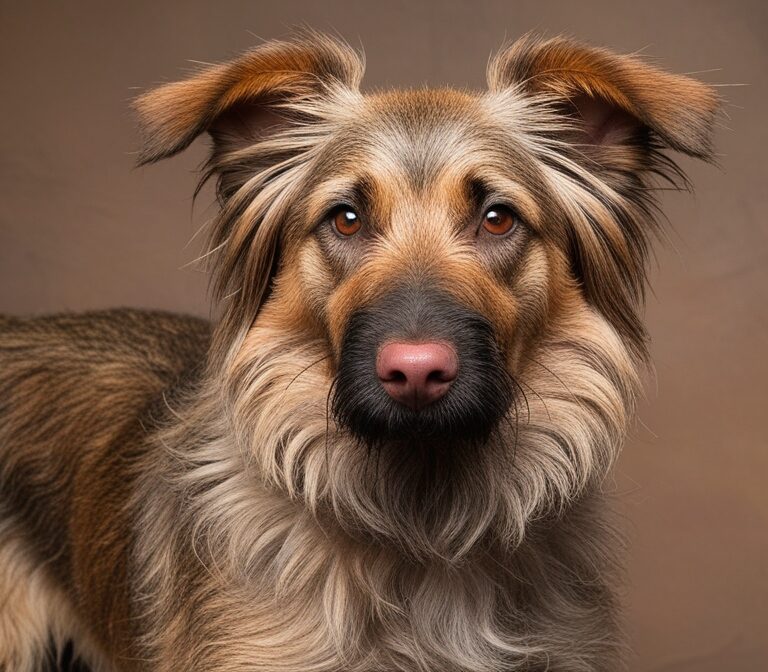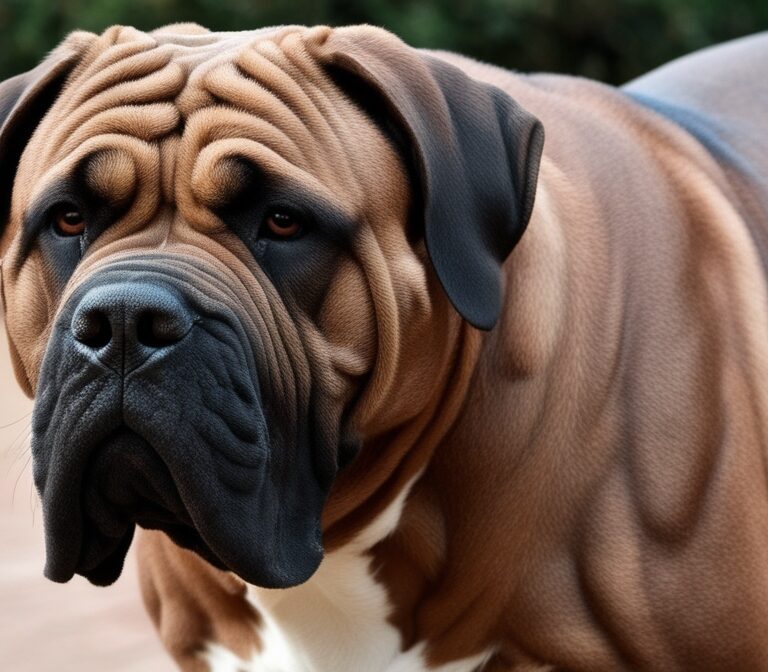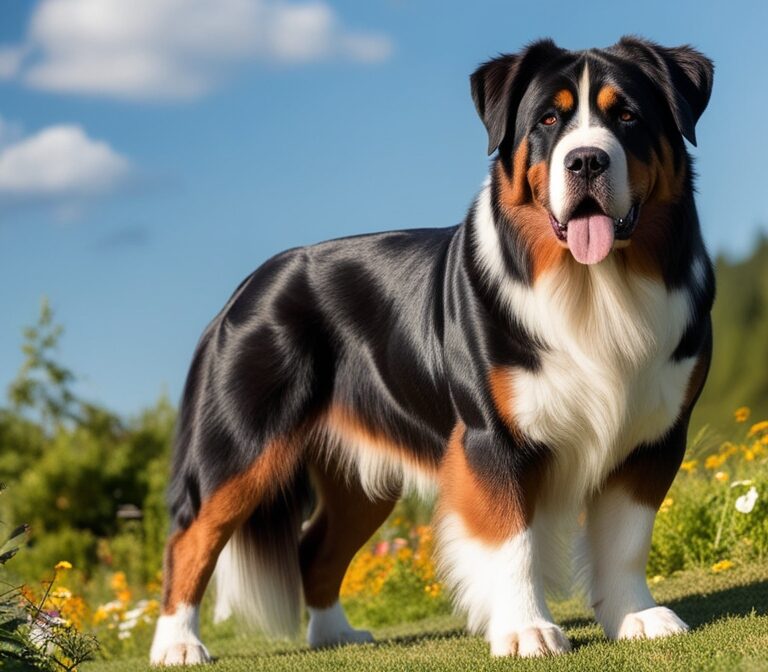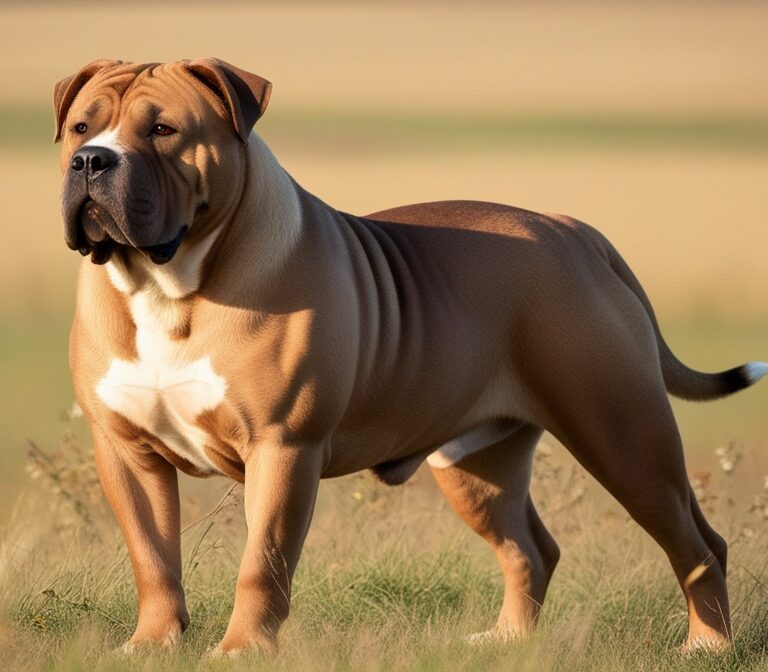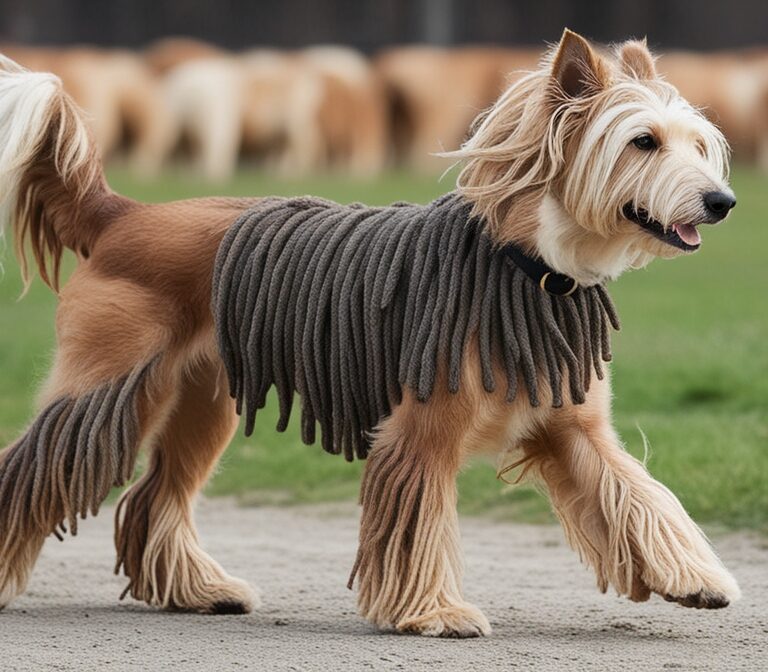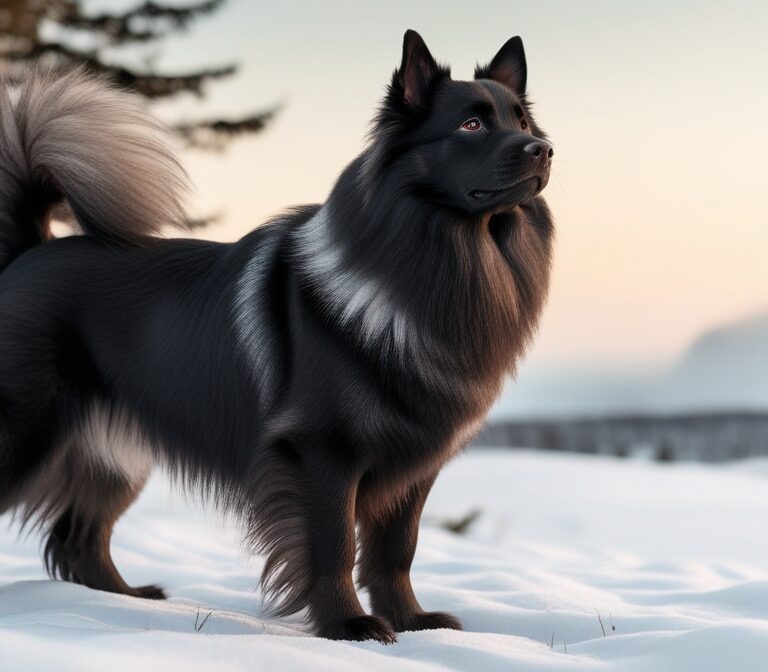The Ultimate Guide to the Shetland Sheepdog (Sheltie)
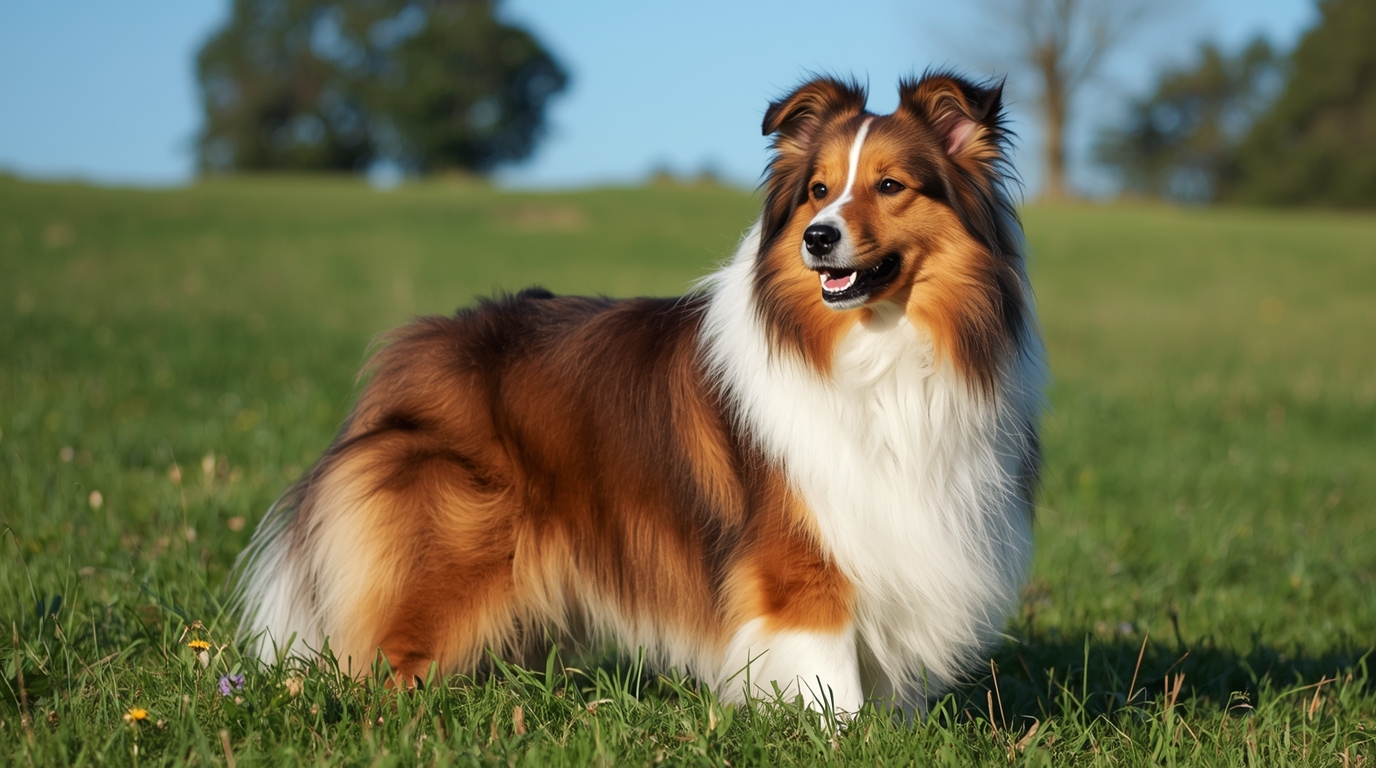
What is a Shetland Sheepdog (Sheltie)?
The Shetland Sheepdog, commonly called a Sheltie, is a herding dog breed that originates from the Shetland Islands of Scotland. Known for its intelligence, loyalty, and agility, the Sheltie has become a popular choice for families, dog sports enthusiasts, and people looking for a highly trainable companion. Unlike larger collie breeds, the Shetland Sheepdog is small to medium-sized, making it easier to manage while still retaining the energy and skill of a true working dog.
Shelties are often mistaken for miniature Rough Collies because of their striking resemblance. However, they are a distinct breed with their own breed standards recognized by major organizations such as the American Kennel Club (AKC), United Kennel Club (UKC), and The Kennel Club (UK). Their double coat, which includes a long, straight outer layer and a dense undercoat, gives them a majestic appearance but also requires regular grooming.
One of the defining traits of a Sheltie is its keen intelligence. Ranked among the top 10 most intelligent dog breeds according to canine psychologist Stanley Coren, Shelties excel in obedience training, agility competitions, and herding trials. Their responsive nature makes them quick learners, although their sensitive temperament means they thrive best with positive reinforcement training methods.
In addition to their intelligence, Shelties are known for their affectionate personalities. They form strong bonds with their families and are often described as being both alert watchdogs and gentle companions. This balance of protectiveness and playfulness makes them ideal for households with children, other pets, and active lifestyles.
Whether you’re interested in a Sheltie for its working heritage, its sporting abilities, or simply as a loving pet, this breed offers a unique blend of energy, elegance, and loyalty. The following sections will dive into the history, characteristics, temperament, care, health, and training needs of this remarkable breed to help prospective owners and enthusiasts gain a full understanding of what it means to live with a Shetland Sheepdog.
The Origins of the Shetland Sheepdog
The Shetland Sheepdog, or Sheltie, traces its roots to the Shetland Islands, a rugged and windswept archipelago located northeast of Scotland. These islands are famous not only for their small, hardy ponies and sheep but also for producing one of the world’s most intelligent and adaptable herding dogs. The origins of the breed reflect both geography and necessity: in such a harsh environment, farmers needed a dog that was compact, efficient, and agile enough to manage livestock across rocky terrains and limited pastures.
Unlike larger sheepdogs found on the Scottish mainland, the Shetland Islands demanded smaller working dogs. Limited resources made it impractical to keep large animals, so both the livestock and the working dogs were bred for small size, hardiness, and efficiency. Early Shelties were likely descended from spitz-type dogs, possibly brought to the islands by Norse settlers, which were later crossbred with local working breeds and small Rough Collie-type dogs. Over time, these selective breeding practices refined the Sheltie into a distinct type that could handle the unique challenges of herding in the Shetlands.
By the late 19th century, visitors to the islands began noticing these small collie-like dogs. Sailors and tourists took some back to mainland Britain, where further refinement occurred through selective breeding with Collies and possibly Papillons to enhance certain features like size, coat, and temperament. These breeding efforts helped transform the Sheltie from a purely working dog into both a companion animal and a show dog.
The breed gained official recognition in the early 20th century, with the Kennel Club (UK) acknowledging the Shetland Sheepdog in 1909, and the American Kennel Club (AKC) following suit in 1911. Despite the changes introduced by selective breeding, Shelties retained their strong herding instincts, high energy, and natural intelligence, qualities that make them excellent at both traditional herding and modern dog sports.
Today, the Shetland Sheepdog is celebrated worldwide not only as a beloved companion but also as a testament to the way environment and necessity shape animal breeds. The Sheltie’s origins are a fascinating reminder of how geography, culture, and human needs converge to create a dog that is both beautiful and functional.
Influence of the Rough Collie
The Rough Collie has played a central role in shaping the modern Shetland Sheepdog. While Shelties originated in the Shetland Islands from smaller herding dogs adapted to local conditions, their eventual refinement into the elegant, well-proportioned breed we know today came through deliberate crossbreeding with Rough Collies in the late 19th and early 20th centuries.
Early Shelties, sometimes referred to as “Toonie dogs” (from the word toun, meaning farm), were small, scrappy, and varied in appearance. Some were spitz-like, with pricked ears and curled tails, while others resembled miniature collies. When visitors from mainland Britain saw these dogs, many were drawn to the ones that looked most like the Rough Collie, a breed already gaining popularity thanks to its grace, beauty, and effectiveness as a herding and show dog. Breeders sought to standardize the Sheltie’s appearance by crossing them with purebred Rough Collies, which introduced more refined features such as the long wedge-shaped head, expressive almond-shaped eyes, and abundant double coat.
This crossbreeding gave the Sheltie its iconic “miniature collie” look but also sparked debate. Some purists believed that introducing Collie blood diluted the Sheltie’s working-dog roots, while others argued that it enhanced the breed’s elegance and ensured its acceptance in the broader dog world. Over time, the Sheltie was recognized as a distinct breed, not simply a smaller Rough Collie. Breed clubs emphasized maintaining unique qualities such as the Sheltie’s smaller size, quicker agility, and higher energy levels, distinguishing it from its larger cousin.
Beyond appearance, the Rough Collie also influenced the Sheltie’s temperament. Collies are known for their gentle, family-oriented personalities, and these traits blended with the Sheltie’s innate alertness and responsiveness. The result was a breed that not only excelled in herding livestock but also thrived as a companion animal, well-suited for homes, competitions, and obedience training.
Even today, comparisons between Rough Collies and Shetland Sheepdogs are common, with many people mistaking one for the other. However, while they share a genetic and historical connection, the Sheltie is not simply a scaled-down version of the Rough Collie. It is a breed in its own right, with unique instincts, proportions, and personality traits that set it apart while still honoring the Collie’s influence on its development.
Development in the Shetland Islands
The Shetland Islands, located about 170 kilometers north of mainland Scotland, are characterized by their harsh climate, rugged coastlines, and limited resources. Life on these islands shaped not only the people and livestock but also the working dogs that would eventually become the Shetland Sheepdog. The development of the breed was a direct response to the unique agricultural needs of the region.
Farmers in the Shetlands raised Shetland sheep, which were notably smaller and lighter than mainland breeds due to scarce grazing lands. To manage these flocks, islanders required dogs that were small, agile, and highly responsive—capable of navigating rocky terrain while conserving energy. Early Shelties were perfectly suited for this environment, excelling in herding and guarding duties despite their compact size.
Historical accounts suggest that the Sheltie’s ancestors may have included spitz-type dogs brought by Norse settlers, as well as early Collie-type dogs from Scotland. These breeds blended into a hardy landrace dog that could survive the islands’ unpredictable weather and fulfill multiple roles, from herding livestock to acting as watchdogs around rural crofts. Unlike larger mainland herding breeds, these dogs required less food, making them practical for families with limited resources.
By the 19th century, visitors to the Shetlands took notice of these small, intelligent dogs. Tourists, sailors, and naval officers sometimes purchased them to take back to Britain, where they were occasionally marketed as “Shetland Collies.” However, this name sparked controversy among Rough Collie breeders, who did not want confusion between the two breeds. Eventually, the official name Shetland Sheepdog was adopted to clarify the breed’s distinct identity while acknowledging its working roots.
On the islands, development remained more functional than aesthetic. Farmers valued obedience, stamina, and herding instinct over appearance. Only later, as Shelties reached the mainland and entered the dog show scene, did selective breeding for appearance (such as coat length, head shape, and color variations) become a priority. Still, the Sheltie’s working heritage was never lost. Even modern Shelties—though often kept as companions and show dogs—retain their strong herding instincts, often seen in behaviors like chasing cars, rounding up children, or responding eagerly to herding activities in sports.
Thus, the Shetland Islands were more than just the birthplace of the Sheltie; they were the crucible that shaped the breed’s size, temperament, and working capabilities. Without the challenges of island life, the Sheltie might never have developed into the versatile, intelligent dog we recognize today.
Recognition by Kennel Clubs Worldwide
The journey of the Shetland Sheepdog from a small working dog on the Shetland Islands to a globally recognized breed is deeply tied to the influence of kennel clubs and the emerging popularity of dog shows in the late 19th and early 20th centuries.
The first Shelties brought to mainland Britain often varied in size and appearance. Some looked like miniature Collies, while others retained more spitz-like features. To create uniformity, breeders began selectively pairing dogs that displayed consistent traits: small size, refined head, double coat, and herding ability. By 1909, the Kennel Club (UK) officially recognized the Shetland Sheepdog, cementing its status as a distinct breed.
In 1911, the American Kennel Club (AKC) also granted recognition. The breed was quickly embraced in the United States, where its popularity grew throughout the 20th century. Today, Shelties consistently rank within the top 30 most popular dog breeds in the AKC registry, valued for their intelligence, trainability, and affectionate nature.
Recognition extended beyond Britain and the U.S. The Canadian Kennel Club (CKC), the Australian National Kennel Council (ANKC), and the Fédération Cynologique Internationale (FCI) also acknowledged the breed. While standards across kennel clubs share core characteristics, slight variations exist, especially regarding size limits and accepted coat colors.
Breed clubs played an important role in promoting the Sheltie. Organizations such as the Shetland Sheepdog Club of America (SSCA) and the English Shetland Sheepdog Club (ESSC) not only preserved breed standards but also emphasized health, herding ability, and responsible breeding practices. These clubs remain influential today, sponsoring conformation shows, obedience trials, and agility competitions.
Worldwide recognition ensured that the Sheltie would evolve beyond its island origins. While still valued as a herding dog, the breed’s rise in the show ring and its role as a family companion helped solidify its reputation as one of the most versatile and beloved dogs across continents.
Size and Weight Standards
The Shetland Sheepdog is classified as a small to medium-sized breed, striking a balance between agility and manageability. Breed standards, while slightly different across kennel clubs, generally agree on specific height and weight ranges that define the Sheltie.
According to the American Kennel Club (AKC), Shelties should stand between 13 and 16 inches (33–41 cm) at the shoulder. Dogs outside this range may be penalized in show competitions, though they can still make wonderful companions. The Kennel Club (UK) and FCI follow similar height guidelines, emphasizing proportion and balance rather than absolute size.
In terms of weight, Shelties usually fall between 15 and 25 pounds (7–11 kg), depending on sex and build. Males are often slightly larger and more robust, while females tend to be lighter and more refined. Importantly, Shelties should appear well-proportioned: neither too heavy nor too slight for their height.
The Sheltie’s body is characterized by a graceful outline. The head is wedge-shaped with a slight but distinct stop, tapering to a fine muzzle. The eyes are almond-shaped, giving an intelligent and gentle expression, while the ears are small, flexible, and semi-erect, tipping forward when alert. The body itself is moderately long with a deep chest, well-sprung ribs, and a level topline, all contributing to athletic ability and endurance.
Compared to their larger cousins, the Rough Collies, Shelties offer a more compact and manageable size. This makes them ideal for families living in urban settings, as well as those who want a working dog without the physical demands of a larger breed. Despite their smaller stature, Shelties retain remarkable speed, agility, and stamina, qualities that shine in sports such as agility trials and obedience competitions.
It is also worth noting that overweight Shelties are prone to health problems such as hip dysplasia, joint stress, and reduced lifespan. Maintaining a healthy weight through proper diet and exercise is critical to supporting both appearance and long-term wellness.
In summary, the Sheltie’s size and weight standards reflect the breed’s versatility. Compact enough for modern homes yet athletic enough for active pursuits, the Sheltie’s physical dimensions are a key part of what makes it such a practical and appealing breed worldwide.
Coat Type and Grooming Needs
One of the most defining features of the Shetland Sheepdog is its luxurious double coat, which not only gives the breed its elegant appearance but also serves an important functional role. This coat was originally developed to protect Shelties from the harsh weather conditions of the Shetland Islands, where wind, rain, and cold were part of daily life.
The coat consists of two distinct layers:
- Outer Coat (Guard Hair): Long, straight, and harsh to the touch. It helps repel dirt, rain, and snow while giving the Sheltie its characteristic flowing appearance.
- Undercoat: Soft, dense, and insulating. This layer traps warmth in cold conditions but can shed heavily during seasonal changes.
Because of this double-layered structure, Shelties require regular grooming. Owners should brush the coat at least two to three times per week, with daily brushing recommended during shedding season (typically twice a year, in spring and fall). Neglecting grooming can lead to matting, particularly behind the ears, under the elbows, and in the breeches (the fur on the back of the legs).
Bathing should be done every 6–8 weeks, depending on activity level. Using a dog-specific shampoo and conditioner helps maintain coat health without stripping natural oils. Drying the undercoat thoroughly after bathing is crucial, as trapped moisture can cause hot spots or skin irritation.
Professional grooming is an option for owners who struggle with upkeep, but trimming should be minimal. The Sheltie standard discourages excessive cutting, as the natural flowing coat is part of the breed’s beauty. Basic trimming of paw hair, sanitary areas, and the feathering on legs is acceptable.
In addition to grooming for appearance, maintaining the coat is essential for the dog’s health and comfort. A neglected Sheltie coat can trap dirt and debris, leading to skin infections. On the other hand, a well-maintained coat not only looks stunning but also showcases the breed’s heritage as a hardy working dog built for outdoor environments.
For prospective owners, it’s important to understand that the Sheltie’s coat is not “low-maintenance.” However, many find the grooming process rewarding, strengthening the bond between owner and dog while keeping the Sheltie healthy and show-ready.
Color Variations and Patterns
The Shetland Sheepdog comes in a variety of striking color patterns, all of which contribute to the breed’s elegance and individuality. While coat color does not affect the Sheltie’s temperament or working ability, it is a major focus in the show ring and a key point of interest for breeders and enthusiasts.
Recognized AKC coat colors include:
- Sable: Ranges from golden to mahogany. This is the most traditional and widely recognized Sheltie color, giving them a warm, classic appearance.
- Tri-Color: A striking combination of black, white, and tan. Tri-color Shelties are bold-looking with rich contrasts.
- Blue Merle: A marbled mix of gray, black, white, and sometimes tan. Blue Merles are highly prized for their unique and eye-catching pattern.
- Bi-Black: A clean combination of black and white without tan markings.
- Bi-Blue: Similar to Blue Merle but without tan, offering a silver-blue and white combination.
In addition to these, the Kennel Club (UK) and FCI recognize similar variations, though standards may differ slightly regarding acceptable markings. All Shelties should ideally have white markings in areas such as the chest, legs, feet, and tip of the tail, though excessive white (extending beyond the standard pattern) is considered a fault in show dogs.
Interestingly, coat color genetics in Shelties can be complex. The merle gene, responsible for the dappled Blue Merle and Bi-Blue coats, must be carefully managed by breeders. When two merle-patterned dogs are bred together, the resulting puppies may inherit the “double merle” gene, which increases the risk of deafness and eye defects. Responsible breeders avoid such pairings to protect the health of the breed.
While color patterns can influence show quality and breeding choices, they have no bearing on the Sheltie’s intelligence, temperament, or trainability. Pet owners often choose Shelties based on personality fit rather than coat color, though many do have personal favorites.
Ultimately, whether a Sheltie is sable, tri-color, or blue merle, the breed’s true beauty lies in its expressive face, bright eyes, and flowing coat that embodies both elegance and functionality.
Distinguishing Features of Shelties
The Shetland Sheepdog possesses several distinctive physical traits that make it instantly recognizable, even to those unfamiliar with dog breeds. While it shares similarities with the Rough Collie, its proportions and details give it a unique identity.
One of the most striking features of the Sheltie is its wedge-shaped head. The skull tapers smoothly toward a fine muzzle, with a slight but noticeable stop. This head shape gives the breed an elegant and refined look, often described as “sweet expression”—a hallmark of the breed standard across major kennel clubs. The expression is further enhanced by the almond-shaped, dark brown eyes, which convey both intelligence and sensitivity. In blue merles, eyes may be blue or partially blue, adding to their distinct appearance.
The ears of a Sheltie are another distinguishing trait. They are small, set high, and carried semi-erect—folding forward at the tips when alert. This ear carriage adds to their alert expression and reflects their working heritage, as dogs with upright ears are more responsive to environmental cues and commands.
The Sheltie’s coat is perhaps its most famous feature, consisting of a straight, long outer coat and a dense undercoat. The mane and frill around the neck create a lion-like ruff, while the feathering on the legs and tail add elegance. Unlike some breeds, Shelties are not bred for purely ornamental coats—their double coat originally had a practical function in weather protection.
Another unique characteristic is the Sheltie’s proportions. While compact, the dog is slightly longer than tall, giving it a balanced, athletic frame. This body shape allows for speed, agility, and endurance, making Shelties excellent at herding and modern sports such as agility trials.
Their gait is also a distinguishing feature. The Sheltie moves with effortless, light, and ground-covering strides that reflect efficiency and stamina. In dog shows, judges often watch the Sheltie’s gait closely, as it indicates both physical soundness and breed type.
Taken together—the wedge head, expressive eyes, semi-erect ears, abundant coat, and balanced proportions—these features give the Shetland Sheepdog its unmistakable presence. Whether in a working field, agility arena, or show ring, the Sheltie’s combination of elegance and function sets it apart as one of the most distinctive and admired herding breeds.
Intelligence and Trainability
The Shetland Sheepdog is renowned for its exceptional intelligence, consistently ranked among the top 10 smartest dog breeds in studies of canine cognition. According to Dr. Stanley Coren’s “The Intelligence of Dogs”, Shelties fall just behind Border Collies, Poodles, and German Shepherds in terms of working and obedience intelligence. On average, they can learn a new command in five repetitions or fewer and obey the first command 95% of the time.
This remarkable intelligence makes Shelties highly trainable. They thrive in structured training environments where their quick learning ability can be channeled into positive tasks. Obedience training, agility, rally, and herding trials are areas where Shelties excel, often outperforming larger breeds due to their agility and enthusiasm. Their natural desire to please their owners enhances trainability, though they can also be sensitive to harsh corrections. Gentle methods based on **positive reinforcement—such as treats, toys, and praise—**work best.
Shelties are also skilled in learning complex tasks, making them popular for trick training and advanced obedience work. Many owners report that their Shelties not only master commands quickly but also seem to anticipate routines and read human cues with uncanny accuracy. This attentiveness reflects their herding ancestry, where dogs needed to respond rapidly to shepherd signals while managing livestock independently.
However, intelligence brings challenges. Without adequate mental stimulation, Shelties can become bored, leading to problem behaviors such as excessive barking, digging, or chewing. Owners are encouraged to provide puzzle toys, structured games, and training sessions to keep their Sheltie’s mind engaged. A Sheltie without stimulation may invent its own “work,” often herding children, chasing cars, or fixating on repetitive activities.
Their trainability also makes Shelties excellent candidates for service work and therapy roles. While they are not as large as traditional service breeds like Labradors, their quick learning, gentle temperament, and responsiveness make them suitable for specialized assistance tasks and emotional support.
In summary, the Shetland Sheepdog combines high intelligence with a cooperative spirit, making training both rewarding and enjoyable. They are best suited for owners who appreciate an active, thinking dog and who are willing to invest in consistent training, mental challenges, and interactive play.
Loyalty and Bonding with Families
The Shetland Sheepdog is deeply valued for its loyalty and strong attachment to its human family. Unlike some independent breeds, Shelties are known as “velcro dogs,” meaning they prefer to stay close to their owners at all times. This strong bond stems from their herding ancestry, where attentiveness to the shepherd was essential for survival and work efficiency.
Shelties often choose a primary caregiver within the household, forming an especially strong connection with that person. However, their loyalty extends to the entire family, including children and even other pets. Many Shelties demonstrate a protective nature, serving as both companions and watchdogs. They are not aggressive, but their alertness and tendency to bark make them excellent at warning families of strangers or unusual activity.
Because of their sensitive and affectionate personalities, Shelties can be prone to separation anxiety if left alone for extended periods. They thrive best in homes where someone is present most of the time or where they can participate in daily activities. This need for companionship makes them less suited for owners with very busy lifestyles who cannot provide adequate interaction.
The Sheltie’s loyalty often expresses itself in subtle behaviors—such as following their owner from room to room, responding eagerly to voice commands, or lying quietly nearby while the family relaxes. Their devotion makes them highly responsive in training and also ensures they remain closely attuned to their family’s moods and routines.
Ultimately, the Sheltie’s deep loyalty and affectionate bond are among the breed’s most cherished traits, creating not just a pet but a true family member and companion.
Energy Levels and Playfulness
The Shetland Sheepdog is an energetic and playful breed, reflecting its background as a working herding dog. While smaller than many other herding breeds, Shelties possess high stamina and drive, requiring consistent outlets for both physical and mental energy.
Daily exercise is a must. A Sheltie typically needs at least 60–90 minutes of activity per day, which can include walks, fetch, agility practice, and play sessions. Without adequate exercise, Shelties may become restless or develop behavioral problems, such as excessive barking or destructive chewing.
Playfulness is one of their defining traits. Shelties enjoy interactive games like frisbee, fetch, tug-of-war, and hide-and-seek. They also thrive in structured activities such as agility courses or obedience training, where their sharp minds and quick reflexes are put to good use. Because of their eagerness to engage, Shelties often excel in canine sports and competitions.
Their playful energy makes them excellent companions for children, though supervision is important, especially with very young kids. Shelties may try to herd children by nipping at heels or circling them, a behavior rooted in instinct rather than aggression. With proper training, this instinct can be redirected into positive play.
While energetic, Shelties are also adaptable. They can relax indoors as long as their exercise needs are met. This flexibility allows them to thrive in both suburban homes with yards and apartments where outdoor activity is part of the daily routine.
Overall, the Sheltie’s energy and playfulness make it an ideal breed for active families and individuals who enjoy interactive companionship and outdoor activities.
Common Behavioral Traits
The Sheltie’s behavior reflects its intelligence, sensitivity, and herding instincts. Understanding these traits helps owners anticipate needs and provide proper guidance.
- Alertness: Shelties are highly alert and make excellent watchdogs. They tend to bark when they sense unusual movement, sounds, or strangers approaching.
- Herding Instincts: Even without sheep, Shelties retain their instinct to herd. They may chase cars, bicycles, or even try to round up family members or pets.
- Sensitivity: Shelties are emotionally sensitive. They respond quickly to voice tone and body language, making them highly trainable but also prone to stress in chaotic environments.
- Barking: Known for being vocal, Shelties use barking as communication. This trait can be managed with training but should be considered by potential owners living in noise-sensitive areas.
- Eagerness to Please: Their cooperative nature makes them well-suited for training, sports, and therapy work.
- Shyness with Strangers: While affectionate with family, some Shelties are reserved or shy around new people. Early socialization helps prevent excessive timidity.
These behaviors make Shelties both endearing and challenging. With structured guidance, they develop into well-balanced companions. Owners who appreciate a communicative, attentive, and loyal dog often find the Sheltie’s behavioral traits to be highly rewarding.
Grooming Routines for Double Coats
The Sheltie’s double coat requires consistent care to maintain both health and beauty. A structured grooming routine not only enhances appearance but also prevents matting, skin irritation, and shedding issues.
Brushing: At minimum, Shelties need brushing 2–3 times per week, with daily brushing recommended during shedding season. A slicker brush and undercoat rake are effective tools for removing loose hair and preventing tangles. Focus on problem areas such as behind the ears, under the elbows, and the breeches.
Bathing: A bath every 6–8 weeks is sufficient, though more frequent bathing may be necessary for active dogs. Always dry the undercoat thoroughly to prevent moisture-related skin problems.
Trimming: While Shelties are not a breed that requires full haircuts, trimming is acceptable in areas like paw pads, sanitary zones, and the tips of ears. Over-trimming is discouraged, especially for show dogs.
Seasonal Shedding: Shelties “blow their coat” twice a year, during which heavy shedding occurs. Owners should increase grooming frequency and consider professional grooming assistance during these times.
Additional Care: Regular nail trimming, ear cleaning, and dental care are essential parts of grooming. A holistic routine ensures that Shelties not only look their best but also remain healthy.
For many owners, grooming becomes a bonding experience, reinforcing trust and affection between the dog and its human. Proper coat maintenance ensures that the Sheltie’s iconic beauty reflects its heritage as both a hardy worker and elegant show dog.
Nutrition and Diet Requirements
The Shetland Sheepdog’s diet plays a crucial role in supporting its energy levels, coat health, and overall longevity. As a medium-energy herding breed, the Sheltie requires a balanced diet rich in protein, healthy fats, and essential nutrients.
Protein: A high-quality protein source (such as chicken, lamb, fish, or beef) should form the foundation of the diet. Protein supports muscle development and repair, especially in active Shelties engaged in sports or herding.
Fats: Healthy fats, particularly omega-3 and omega-6 fatty acids, are essential for maintaining the Sheltie’s luxurious coat and supporting brain function. Fish oil supplements are commonly recommended to enhance coat shine and reduce inflammation.
Carbohydrates: Complex carbohydrates from sources like sweet potatoes, brown rice, or oats provide sustained energy. Avoid low-quality fillers like corn and soy, which offer limited nutritional value.
Portion Control: Shelties can be prone to weight gain if overfed, especially if their exercise needs are not met. The average adult Sheltie requires 1–2 cups of high-quality dry dog food per day, divided into two meals. Puppies and highly active dogs may need more, while seniors often need fewer calories.
Special Considerations:
- Some Shelties are sensitive to grains or certain proteins, requiring hypoallergenic or limited-ingredient diets.
- Regular dental care is essential, as small breeds like Shelties can be prone to tartar buildup and gum disease.
- Fresh water should always be available, particularly for active dogs.
A well-balanced diet ensures that Shelties maintain optimal weight, strong immunity, and coat vitality. Owners who tailor nutrition to their dog’s age, activity level, and health needs will enjoy a healthier and more vibrant companion.
Exercise Needs for a Healthy Sheltie
The Shetland Sheepdog is an active and intelligent breed that thrives on daily physical exercise and mental stimulation. Originally bred for herding, Shelties are not content to be sedentary pets. Without sufficient outlets for their energy, they may develop behavioral issues such as excessive barking, chewing, or restlessness.
Most adult Shelties require 60–90 minutes of exercise per day, though highly energetic individuals may need even more. Exercise should include both structured activities (such as long walks, jogging, or fetch) and free play in a secure yard. Shelties excel in off-leash activities when properly trained, but their strong herding instinct means they should only be allowed off leash in safe, enclosed areas.
Beyond physical activity, Shelties also demand mental enrichment. Puzzle toys, obedience training sessions, and agility courses help keep their minds sharp. A Sheltie that is mentally engaged is less likely to develop problematic behaviors.
Puppies and seniors require adjusted routines. Puppies benefit from shorter, frequent play sessions to avoid strain on developing joints, while older dogs may prefer moderate exercise tailored to their health.
Ultimately, exercise is not just about health—it is essential for maintaining the emotional balance of the Sheltie. A well-exercised Sheltie is calmer indoors, easier to train, and more affectionate with family members.
Managing Shedding and Allergies
The double coat of the Sheltie is stunning but also comes with significant shedding responsibilities. Shelties are moderate year-round shedders, with heavy seasonal shedding twice a year when they “blow coat.” During these times, undercoat hair is released in large amounts, requiring daily brushing to control loose fur.
Owners can manage shedding effectively with:
- Regular Brushing: Using an undercoat rake or slicker brush at least 2–3 times per week.
- Vacuuming and Lint Tools: Sheltie fur can accumulate quickly on furniture and clothing.
- Bathing During Shedding Season: A warm bath followed by thorough drying and brushing helps release loose hair.
Allergies are another consideration. While Shelties are not hypoallergenic, regular grooming and cleaning can reduce allergens in the home. People sensitive to dog dander should brush Shelties outdoors and use air purifiers indoors.
Shelties with skin allergies may also require diet adjustments or hypoallergenic shampoos. Common triggers include grains, poultry, or environmental factors like pollen. Veterinary guidance ensures proper management of allergy-related coat issues.
By staying on top of grooming and shedding, owners can enjoy the Sheltie’s coat without letting it overwhelm the household.
Obedience Training for Shelties
The Shetland Sheepdog excels in obedience training thanks to its intelligence, responsiveness, and eagerness to please. Ranked among the most trainable breeds, Shelties can master commands quickly and perform them reliably.
Training should begin in puppyhood, focusing on socialization, basic commands (sit, stay, come, down), and leash manners. Shelties respond best to positive reinforcement methods, including treats, toys, and praise. Harsh corrections can damage trust, as Shelties are naturally sensitive and may shut down if training feels negative.
Consistency is key. Short, engaging sessions of 10–15 minutes are more effective than long, repetitive drills. Shelties enjoy learning new tricks and thrive in environments where training feels like play.
Common obedience goals include:
- Reliable Recall: Essential due to their herding instinct and tendency to chase.
- Controlled Barking: Training Shelties to respond to “quiet” commands can reduce excessive vocalization.
- Focus in Distracting Environments: Useful for urban settings, competitions, and public outings.
Advanced training often leads Shelties into competitive obedience trials, where their precision and enthusiasm make them standouts. Many also succeed in therapy dog work because of their ability to remain calm, attentive, and affectionate.
Obedience training is more than just commands—it builds a strong bond of trust between Sheltie and owner, ensuring a happy and cooperative relationship.
Agility Sports and Competitions
Few breeds rival the Shetland Sheepdog in the arena of agility sports. Compact, quick, and intelligent, Shelties dominate agility competitions worldwide, often competing against larger working breeds with great success.
Agility involves navigating obstacle courses that include tunnels, weave poles, jumps, and contact equipment such as seesaws and A-frames. Shelties excel because of their speed, flexibility, and eagerness to work closely with handlers. Their sharp minds allow them to quickly learn course layouts, while their athletic bodies deliver the speed needed to win.
In fact, Shelties consistently rank among the top-winning breeds in agility competitions hosted by organizations such as the American Kennel Club (AKC) and United States Dog Agility Association (USDAA). Their popularity in agility is second only to Border Collies, another herding breed with similar traits.
Beyond competition, agility provides mental stimulation and physical exercise, making it an ideal activity for Shelties in everyday life. Even for non-competitive owners, backyard agility setups or obedience drills can enrich the dog’s life.
Agility also strengthens the bond between handler and dog, as success depends on teamwork and trust. A Sheltie that excels in agility is not only a joy to watch but also an ambassador for the breed’s intelligence and versatility.
Herding Instincts in Modern Times
Despite their popularity as companions and show dogs, Shelties retain strong herding instincts rooted in their working heritage. These instincts often surface in behaviors such as chasing cars, circling children, or rounding up other pets. While sometimes challenging for urban households, these instincts are part of what makes Shelties so unique.
Shelties are highly responsive to movement, sound, and environmental changes—traits that were vital for managing flocks in the Shetland Islands. Even without exposure to sheep, many Shelties will display herding behaviors naturally. For example, they may crouch low, dart quickly, or nip at heels when excited.
Today, herding ability is preserved through herding trials and instinct tests organized by breed clubs. These events allow Shelties to demonstrate their natural skills in a controlled environment with livestock. Many Shelties prove remarkably adept, showcasing agility, focus, and precision.
For families, managing herding behavior is important. Training can redirect these instincts into safe outlets such as agility, obedience, or structured games. However, some herding tendencies—like alert barking or strong reactions to movement—remain part of the breed’s identity.
In modern life, the Sheltie’s herding instinct translates into alertness, responsiveness, and drive, making them excellent working partners, sports competitors, and loyal companions. It is a living connection to their heritage, reminding owners of the breed’s roots as a true working dog.
